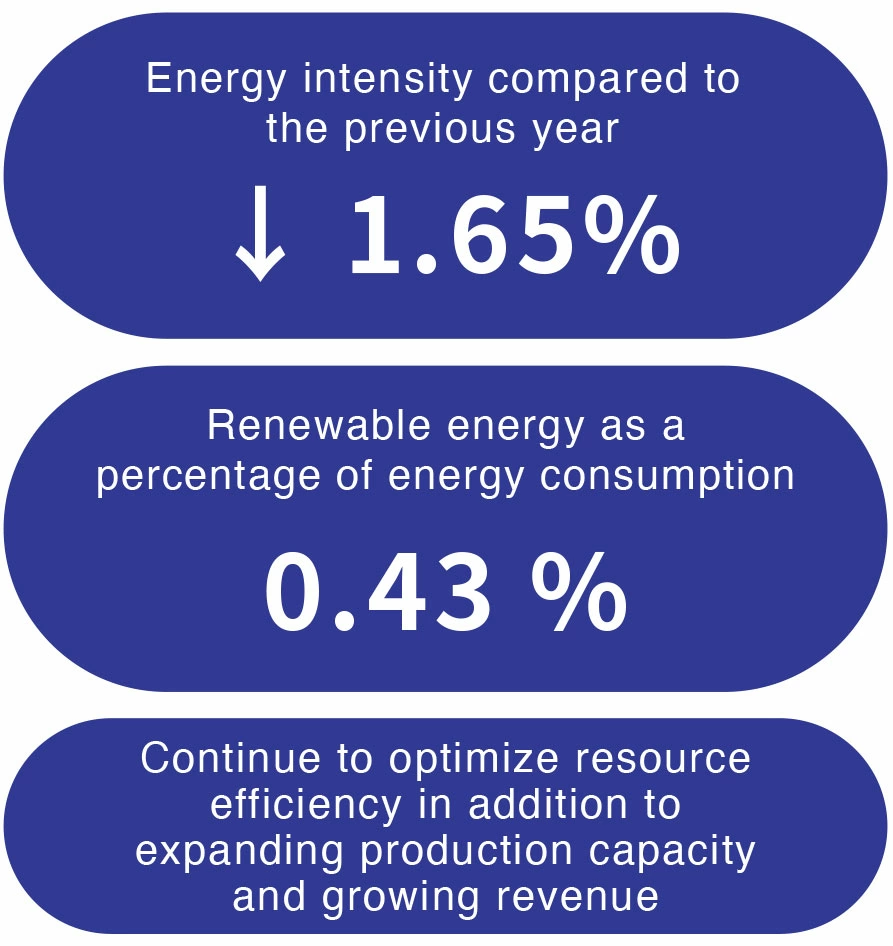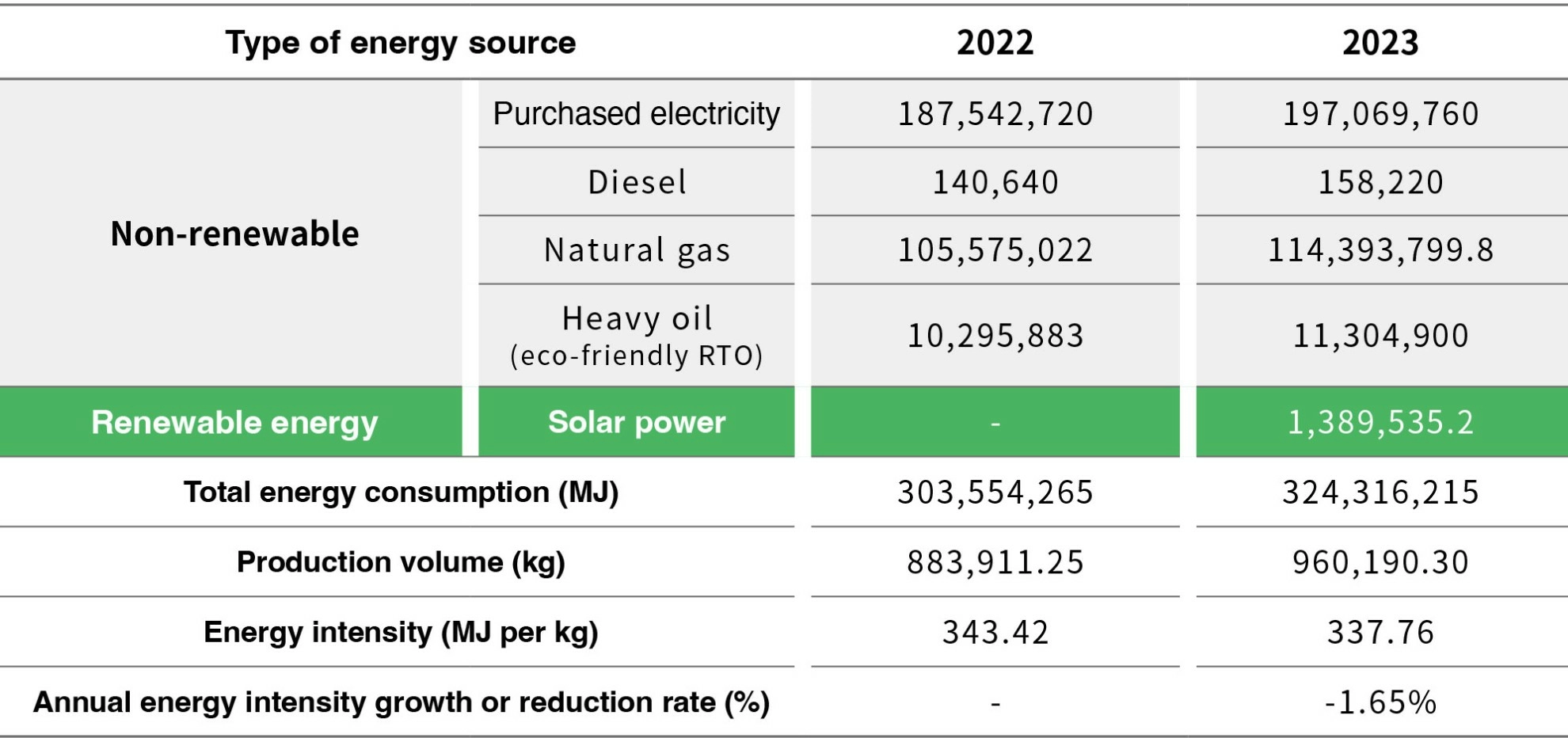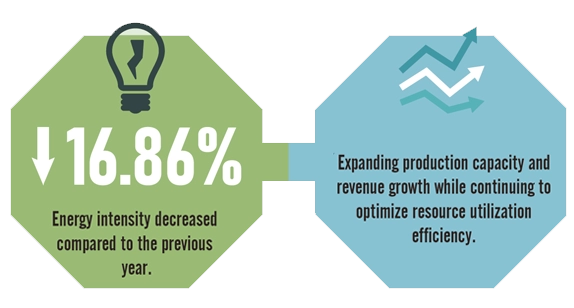
Energy Management
The intensive use of air-conditioning systems in factories and storage spaces across the biopharmaceutical industry for the purpose of maintaining temperature and humidity control for raw materials and products has resulted in high electricity consumption. Therefore, how to reduce energy consumption and increase the percentage of green energy in our energy structure becomes a critical development strategy for us. With the goal of setting up green electricity that reaches at least 10% of Taipower’s contract capacity of 7,500 kW at Formosa Laboratories in 2024, we not only assess the setup of renewable energy and the installation of energy storage systems, but also continue to draw up our annual electricity saving measures in hopes of bolstering our resilience to climate change and minimizing operational risks.
In 2023, Formosa Laboratories consumed 324,316,215 MJ of energy in total, where renewable energy accounted for 0.43%. Formosa Laboratories reported an energy intensity of 337.76 MJ per kg, which was calculated based on production volume (expressed in kg), where this figure was still lower than that in the previous despite the higher amount of electricity consumed due to plant expansion and increased production capacity.
▼Use of energy sources within the organization (Unit: megajoules or MJ)

Note:
- The boundary of energy survey includes the entire area of office premise at Formosa Laboratories’ headquarters, Louchu Plant, and Louchu No. 2 Plant.
- The energy conversion factors were taken from the Greenhouse Gas Emission Factor Management Table Version 6.0.4 published by the Ministry of Environment, where 1 cubic meter of natural gas - 10.5 kWh of electricity; 1 liter of diesel = 8,400 kCal = 35.16 MJ; 1 kWh of electricity = 3.6 MJ; 1 liter of heavy oil = 41.87 MJ.
- There was no data regarding solar power in 2022 as electricity generation using solar energy only began at the end of June 2023.
- Restatement of information: The 2022 data regarding all types of energy sources, except for purchased electricity, was adjusted due to incorrect insertion of the aforesaid data and the change of unit of denominator in the formula for calculating energy intensity from NT$ million in revenue to production volume (kg).

Energy Management
As a major supplier of API for biopharmaceuticals, the Company is fully aware of the impact and risks brought about by climate change. Therefore, reducing energy consumption and increasing the proportion of green energy is also a continuous effort for the Company. We investigated the electricity and energy usage in our headquarters, Louchu Plant, and Louchu Plant 2, with a total energy consumption of 187,542,852.23 million joules in 2022. The energy intensity, calculated based on per thousand New Taiwan Dollars of revenue, is 49.30.
The energy in current use mainly comes from the electricity for equipment and office spaces, accounting for almost 100% (99.99994%) of the total energy usage. The remaining small amount of energy is used for diesel, natural gas, and heavy oil from the regenerative thermal oxidizer (RTO). Due to the addition of production lines, research and development systems, and a new injection factory, the overall electricity demand of the organization has increased. However, we are also making efforts to reduce electricity consumption by replacing old equipment with energy-saving devices, resulting in a slight decrease in total energy consumption in 2022 compared to the previous year. If we calculate the energy intensity based on revenue per thousand New Taiwan Dollars, there is a 16.86% decrease in 2022 compared to the previous year, which demonstrates the Company's improvement in energy efficiency.
Our main focus for improvement will continue to be energysaving measures. We will reduce electricity consumption by renewing the manufacturing processes or production equipment. We also plan to use renewable energy such as solar power to diversify sources of energy and reduce energy consumption risks.
Formosa Laboratories Use of Internal Energy

Note 1 : The energy conversion coefficient is retrieved from the greenhouse gas emission coefficient management table version 6.0.4 announced by the Environmental Protection
Administration.
Note 2 : Energy Intensity Calculation Formula: Total Energy Consumption / Revenue (in thousand New Taiwan Dollars).